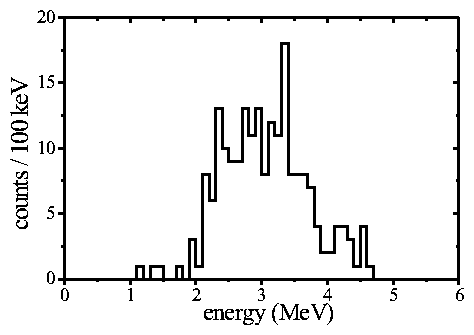| Decay Properties of Pd A,G | |||
|---|---|---|---|
| K. Schmidt1,5, C. Mazzocchi1,2, R. Borcea1, J. Döring1, S. Galanopoulos3, M. Go\'rska1, H. Grawe1, S. Harissopulos3, M. Hellström4, Z. Janas1, R. Kirchner1, G. Kriembardis3, M. La Commara1, A. Ostrowski5, G. Rainovski, E. Roeckl1 | |||
|
Neutron-deficient isotopes in the vicinity of the N = Z line have
attracted considerable experimental and theoretical attention over the last
years. Among the key points of interest are investigations in the framework of
the astrophysical rp-process [1] and studies of the residual proton-neutron
interaction [2]. Reaction network calculations of the rp-process [3]
identified, along with other isotopes such as 92Pd and 96,97Cd, the
very proton-rich nucleus 93Pd (Z = 46, N = 47) as a probable waiting
point in the reaction path in X-ray burst scenarios. Calculations of this kind
require, amongst other nuclear properties, b-decay half-lives as input
parameters.

Fig. 1 Energy spectrum of b-delayed protons recorded at mass A = 93. In addition to the measurement of b-delayed protons, b-delayed g-rays were investigated by using an array of 13 germanium detectors and a plastic scintillator, mounted at a separate beamline. Gamma transitions of 239.7 keV, 381.7 keV, 621.7 keV, and 864.1 keV were identified in measurements of mass-separated A = 93 sources and preliminarily assigned to the decay of 93Pd. The time characteristics of these g-lines yield a half-life of T1/2 = (1.0 ±0.3) s in good agreement with the value deduced from the proton data. Shell model calculations in the mass range A = 86-100 [4] predict a ground-state spin of either 7/2+ or 9/2+ for the isotope 93Pd, while a low-lying 1/2- isomer can not be excluded. The calculated disintegration mode of the ground-state is an allowed Gamow-Teller b-decay with a half-life of T1/2 = 1.4 s. Due to the good agreement with the calculations, we attribute the observed activity of b-delayed protons and g-rays to the ground-state decay of 93Pd. 93Ag, on the other hand, is predicted [4,5] to be unbound with respect to direct proton emission from its ground state. The search for direct protons at mass A = 93 was unsuccessful.
1 GSI, D-64291 Darmstadt, Germany
References
[1] R.K. Wallace and S.E. Woosley, Astrophys. J. Suppl. 45, 389 (1981)
|